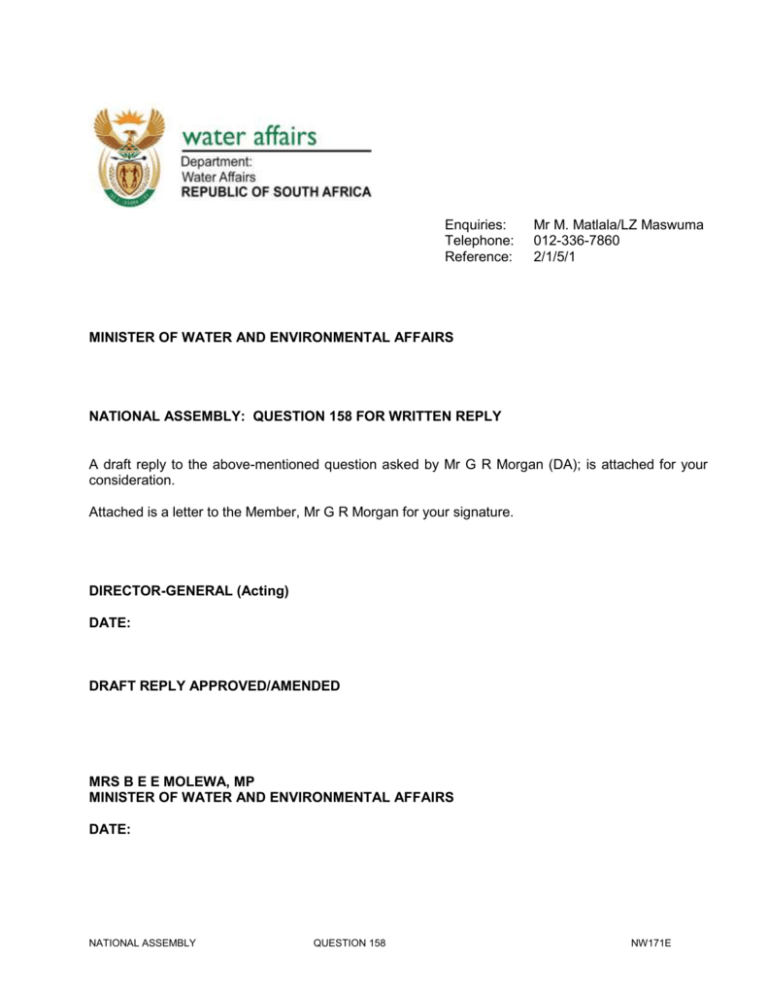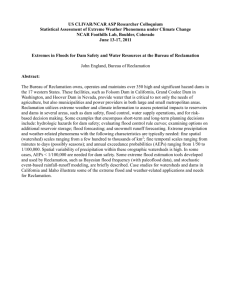Enquiries: Mr M. Matlala/LZ Maswuma Telephone: 012-336
advertisement

Enquiries: Telephone: Reference: Mr M. Matlala/LZ Maswuma 012-336-7860 2/1/5/1 MINISTER OF WATER AND ENVIRONMENTAL AFFAIRS NATIONAL ASSEMBLY: QUESTION 158 FOR WRITTEN REPLY A draft reply to the above-mentioned question asked by Mr G R Morgan (DA); is attached for your consideration. Attached is a letter to the Member, Mr G R Morgan for your signature. DIRECTOR-GENERAL (Acting) DATE: DRAFT REPLY APPROVED/AMENDED MRS B E E MOLEWA, MP MINISTER OF WATER AND ENVIRONMENTAL AFFAIRS DATE: NATIONAL ASSEMBLY QUESTION 158 NW171E NATIONAL ASSEMBLY FOR WRITTEN REPLY QUESTION NO 158 DATE OF PUBLICATION IN INTERNAL QUESTION PAPER: 10 FEBRUARY 2011 (INTERNAL QUESTION PAPER NO. 01) 158. Mr G R Morgan (DA) to ask the Minister of Water and Environmental Affairs: (1) With reference to the Vaal Dam hydrograph for the period 30 December 2010 to 20 January 2011 (details furnished), why was the dam on 30 December 2010 already permitted to be over 100% capacity when weather forecasts at the time predicted the likelihood of increased rainfall in the period going forward; (2) why was the capacity of the dam permitted to exceed 102% between 1 January 2011 and 3 January 2011 without any adjustment in the outflow from the dam; (3) why was the rapid escalation in outflow from the dam that was permitted between 5 January 2011 and 7 January 2011 not started earlier in order to reduce the peak of the outflow; (4) what are the (a) names and (b) designations of all persons involved in the management of the percentage capacity of the dam during the above period; (5) whether she was personally briefed by her officials during the above periods on (a) the changing percentage capacity of the dam and (b) the management of the outflow during this period; if not, why not; if so, what are the relevant details? NW171E ---00O00--REPLY: The “management” of floods in the Vaal/Orange River system is carried out in terms of a Technical Guide which is the result of more than 30 years of hands on action, experience and development in the flood management and flood forecasting of the Vaa/Orange River System a very large catchment, half the size of South Africa. This Guide combines existing institutional memory and experience into a document which is used during a flood event and also to develop and train knowledgeable people in order to enable flood managers to correctly apply the basic principles of flood management without much practical experience of the real situation. During a flood event the Flood Management Office collects substantial real time and forecasted data which is processed, analysed and fed into the flood routing system to enable the Flood Management Personnel to make decisions on releases of water from those dams which have controlled spillways and also to provide the Disaster Management Centers (National and Provincial) with accurate information regarding the stage of the river system. The training and development of knowledgeable hydrologists, technicians and engineers in flood management takes many years mainly for 2 reasons: NATIONAL ASSEMBLY It takes 10 years or longer to know and understand the behavior of each river and flow gauging stations in the catchments. This will enable the person to distinguish between correct and incorrect real time data vital for immediate decision making during a crisis situation. To solve a hypothetical flood routing problem during training in office differs very much from the real world situation. Training in the real world situation does not happen frequently, for example since 1988 there have only been 4 major floods experienced (1988, 1996, 2010 and 2011). QUESTION 158 NW171E -2The main objectives of flood management are: Ensuring the safety of the structure and therefore human life; Minimisation of damage. (The emphasis will be on optimal utilisation of dams and rivers in the system to reduce peak flows and not necessarily on the optimum operation of each dam individually); and Ensuring that the dams are 100% full at the end of the flood event. River flow in South Africa is monitored with the help of various telemetry systems receiving flow and rainfall data from more than 450 gauging stations. The data is transmitted from the different flow gauging stations via different communication links, including satellite, to the Flood Management Room in Pretoria and the Disaster Recovery Center at Vaal Dam. The real time flow and stage data is then used as input to the flood routing model. The maintenance of the South African Real Time Data System is a major task. Skilled hydrologists, technicians and engineers are used for maintaining the hard and software of the system. During flood situations a wide network of both people and technology is put into action. The crucial first step is the gathering of accurate information about rainfall and runoff in the catchment areas of the rivers and the storage levels and inflows into dams. Rainfall / Runoff prediction models are used mainly during the period just after the rainfall event before runoff reaches the gauging stations in the rivers. This gives an early indication of expected flows and volumes that will reach the dams. Rainfall, weather patterns and forecasts are regularly monitored to get a clear picture of what has happened up to now (rainfall), what is happening now (present rainfall areas and intensities by monitoring satellite images and radar) and what will happen in the next few days (short and medium term weather forecast). (1) Previous experiences have taught that it would be irresponsible to act on weather forecasts alone as they serve to place the Department on alert. The Department reacts on measured rainfall and flows observed at flow gauging weirs in our rivers. This gives a safe window of between two and three days before the water reaches the Vaal Dam. (2) The Vaal dam is one of a number of major dams in the Vaal/Orange River systems which are managed as part of the system during a regional flood event as experienced in January 2011. Decisions are therefore based on the state of the entire system (all dams as well as the stage of the rivers) during such a flood event and not on a single dam in the system. The Vaal cannot therefore be analysed on its own without taking into account the stage of the rivers as well as the state of the other dams in the system. (3) Falls away. (4)(a) There are eight officials who are responsible for flood management in the flood management room (details furnished). (4)(b) The team comprise of the following: NATIONAL ASSEMBLY Two Chief Engineers; Three Specialist Engineers; Two Production Scientists (Hydrologists); and One Senior Software Developer. QUESTION 158 NW171E -3- (5)(a) Yes, from 24 December 2010 I was kept informed on a daily basis. On 06 January 2011 I visited both the flood management room as well as the Vaal Dam and on 10 January 2011; I conducted an inspection of the Vaal River as far as the confluence with the Orange River at Douglas. (5)(b) Yes, information regarding the management of the outflow was communicated to me by the management team of the Department on a daily basis ---00O00--- NATIONAL ASSEMBLY QUESTION 158 NW171E









![My Flood Project [WORD 624KB]](http://s3.studylib.net/store/data/007180649_1-37937117fa0d9f223031a6f75d9a4179-300x300.png)